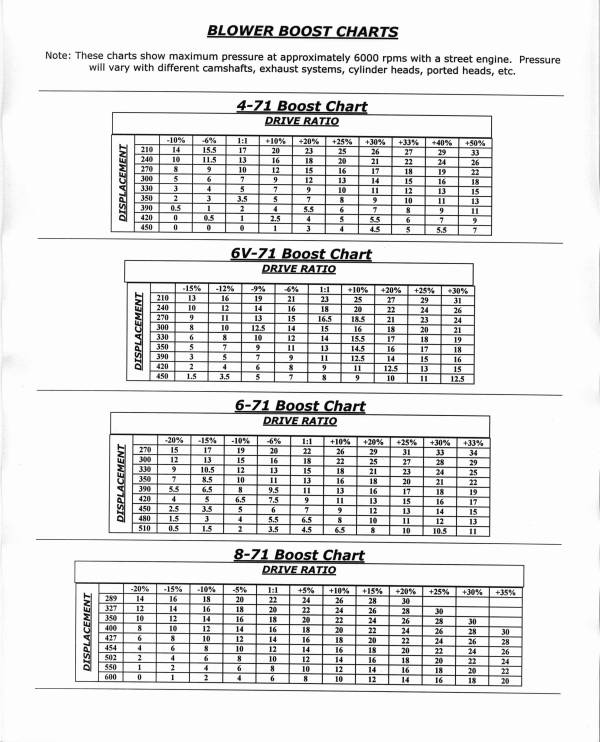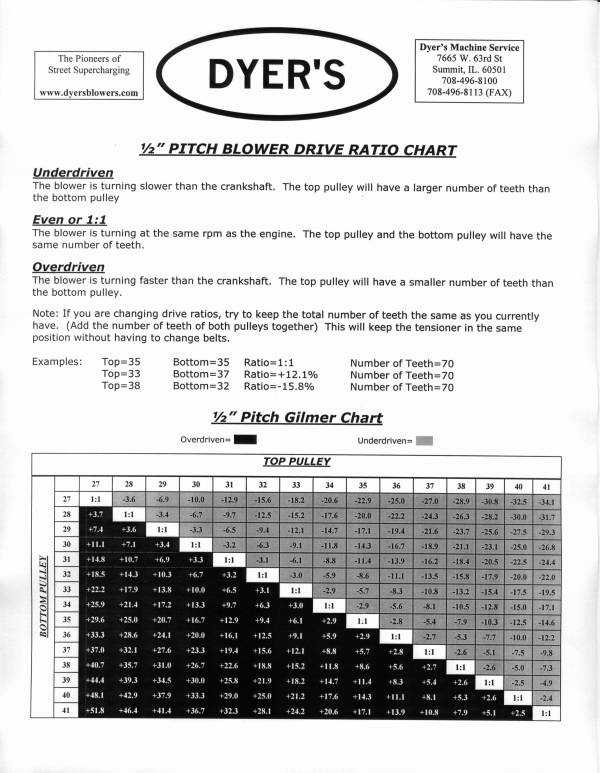
Moparts Tech Archive
Blown Big Block Info
Weiand 6-71 Drive Ratio & Estimated Boost Chart (PSI)
Engine |
Drive ratio (Overdriven) | ||||||||||||
|---|---|---|---|---|---|---|---|---|---|---|---|---|---|
| 1.30:1 | 1.25:1 | 1.20:1 | 1.15:1 | 1.10:1 | 1.05:1 | 1:1 | 0.95:1 | 0.90:1 | 0.85:1 | 0.80:1 | 0.75:1 | 0.70:1 | |
| 30% | 25% | 20% | 15% | 10% | 5% | 0% | -5% | -10% | -15% | -20% | -25% | -30% | |
Effective Compression Ratio Chart
|
Static Compression Ratio |
Blower Boost Pressure (psi) | ||||||||||||
|---|---|---|---|---|---|---|---|---|---|---|---|---|---|
| 2 | 4 | 6 | 8 | 10 | 12 | 14 | 16 | 18 | 20 | 22 | 24 | 26 | |
| Supercharger Type |
Approximate CID or Air Per Revolution |
|---|---|
What's the difference between underdrive and overdrive?
The drive ratio of a supercharger is the speed of the supercharger in relation to crank speed. A drive ratio of 10% underdrive means when the engine is running 6000 rpms, the blower is running 10% slower or 5400 rpms. Overdrive is when the crank pulley is larger than the upper pulley, underdrive is when the crank pulley is smaller than the upper pulley.
How do I calculate the blower drive ratio?
To calculate the drive ratio, take the difference between the 2 pulleys and divide that number by the lower pulley. For example, if you have a 41 top and a 34 crank, the difference is 7 teeth. 7/34=20.6%. Since the upper pulley is larger than the crank, it is 20.6% underdrive.
What spark plugs should I use with a blown engine?
On a street driven vehicle, you should use spark plugs that are 2 heat ranges hotter than the stock. For example, a small block chevy uses AC43 standard, so a blown engine would use an AC45 plug.
How much horsepower will I get with a Dyer's Blower Kit?
For street engines on 93 octane pump gas, a common figure is 1.5hp/CID. A 350 Chevy will make 525hp on pump gas. The maximum hp available for gasoline engines is 2.0hp/CID @ 15 lbs of boost. This requires dyno tuning to ensure the fuel system and ignition are tuned correctly.
Troubleshooting Information
Here's some solutions to common problems with supercharged engines.
1. Needle and seats too small in carbs. We recommend using a pair of Holley #4779 carburetors on most applications. These carbs utilize the .110" needle & seats.
2. Make sure you have a minimum of 5 psi of fuel pressure to the carbs at all times. A fuel pressure gauge is recommended.
3. Jets no large enough in carburetor secondaries.
4. Spark Plug heat range may be too hot or the plugs may be fouled out.
5. Valve float at high RPM. May need stronger intake springs.
6. Ignition break down or bad plug wires.
1. Vacuum leak due to blown pop-off gasket, blown base gasket or leaky intake manifold gaskets or leak between blower case and end plates.
2. Primary Jets in carburetor too small.
3. Idle mixture set too lean.
4. Accelerator pump too small or not pumping enough fuel.
1. Vacuum leak.
2. Carburetor gasket no sealing entire carb base.
3. Carburetor secondary plates not closing all the way.
4. Gasket blown in pop-off plate.
5. Gasket blown between blower and intake manifold.
6. Power Valve in Holley carb is ruptured.
7. Intake Gaskets leaking.
1. Carbs flood - possibly dirt or rubber particles from fuel system trapped in needle and seats of carb. FUEL FILTERS ARE A MUST.
2. Fuel Pressure
A. Absolute minimum - 5 psi
B. Preferred pressure - 6-7 psi
C. If blower is overdriven - may need to increase fuel pressure 1-2 psi
D. If blower is underdriven - higher than recommended fuel pressure may cause flooding
3. Fuel leaks out of accelerator pump - Air flow over blower can create a strong enough vacuum to pull fuel from accelerator pump. A simple air dam attached to carb above accelerator pump will work.
1. Not enough air movement over radiator at low speeds. First off this can be checked by driving the vehicle at highway speeds. If temperature drops there is a low speed air movement problem.
A. We recommend using a high performance mechanical fan with a shroud where possible.
B. Don't use a clutch on the mechanical fan.
C. We recommend using a high flow 180 degree thermostat.
D. When using electric fans, a shroud is still needed and may require fans on both sides of the radiator for sufficient cooling.
2. If highway driving does not cool the engine, there can be a water movement or cooling capacity problem.
A. We recommend using a high performance 4 core radiator to increase cooling capacity.
B. We recommend using a high performance aftermarket water pump to increase water movement through the radiator.
3. Vacuum leaks.
4. Too radical of camshaft.
5. RPM too high at idle.
6. Transmission cooler or A/C Condenser in front of radiator.
7. Fan belt too loose.
8. A supercharger will usually cause 5-10 degrees of extra heat in an engine. You can remove the blower belt and run the engine to isolate this from consideration.
9. Thermostat defective.
10. Idle mixture screws in too far causing extreme lean condition at idle.
11. Not enough initial timing.
12. Too restrictive of exhaust system.
This is common with a supercharger due to the increased exhaust volume and temperature.
1. Increase initial timing - We recommend 14 to 18 degrees initial timing.
2. Turn in idle mixture screws to lean down engine at idle.
3. Increase size of exhaust system - We recommend using 1-7/8 or larger headers with a minimum 2-1/2 pipes out with high flow Flowmaster mufflers.
1. Too thick of base gasket - We recommend using a thin base gasket or using a fuel resistant sealant on the base of the blower. A thick gasket may distort the case and lock the blower.
2. Surface of intake may not be flat. Make sure the intake is flat by using a straight edge to check flatness.
3. Bottom surface of blower may not be flat. Make sure the blower base is flat by using a straight edge to check flatness.
1. Idler arm won't stay tight - There may be oil between the snout and arm. Loosen arm, slide back and clean area thoroughly. If problem persists, you may need to use locktite between arm and snout.
2. Detonation - Caused by too low octane fuel, too much boost, and too much timing.
3. Engine smoking at idle.
A. Blower seals may be damaged. Keep an eye on the level of oil in blower gearcase to see if seals are leaking.
B. PCV system may be allowing oil to be sucked through carburetors. Make sure there is a baffle in valve cover under PCV to eliminate problem.
4. Idler pulley noisy.
A. Shaft may be spinning inside bearings. Rotate pulley and check bearing rotation. Put locktite on shaft to help eliminate slippage.
B. Bearings may be bad. Check and change bearings if necessary.


For a 440, You can use a Speed Pro flat top piston part # L2388F+.030 and a .047 Fel Pro head gasket with your 88cc heads and end up right at 8:00 to 1 compression with minimun decking to the block. That piston has a thick top so it should hold up to the blower. Don't be surprised if you get more like 700+ hp out of your motor with 7 to 9 lbs of boost on pump gas.
Info From:

Tech Index